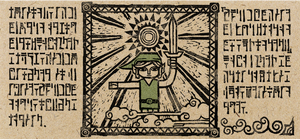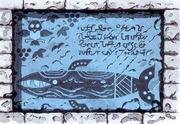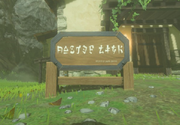
Modern Hylian Text depicting the legend of the Hero of Time
The Hylian Language (![]()
![]()
![]()
![]()
![]()
![]() ) is the main language that is used throughout the Legend of Zelda series. The language is spoken within the lands of Hyrule, Termina, Holodrum, Labrynna, and almost all other surrounding regions, although some other languages such as Sky Writing and the Language of the Minish are also used by other races. Although used by the majority of the people, the language has often seen dramatic changes throughout its history. So far, there are known to be at least four different versions of Hylian, most of which are written with syllabic writing systems.
) is the main language that is used throughout the Legend of Zelda series. The language is spoken within the lands of Hyrule, Termina, Holodrum, Labrynna, and almost all other surrounding regions, although some other languages such as Sky Writing and the Language of the Minish are also used by other races. Although used by the majority of the people, the language has often seen dramatic changes throughout its history. So far, there are known to be at least four different versions of Hylian, most of which are written with syllabic writing systems.
History[]
Ancient Hylian Alphabet[]
The Ancient Hylian Alphabet appears in The Legend of Zelda: Skyward Sword. Like the Hylian alphabet of Twilight Princess, it can be translated to English. Unlike other various written languages in the Legend Of Zelda series Hylian is the only language that is spoken to contact the three goddesses of Hyrule.
Old Hylian syllabary[]

A sample text of Old Hylian
The earliest form of Hylian known to be used after Hyrule was formed was the Old Hylian syllabary, which was likely invented by the founding Hylians. This early form of Hylian was very angular in appearance and was best suited for carving in stone and wood. Old Hylian also made no spaces between words, only in sentences. Eventually this version of Hylian would come to be replaced by both the Hylian Alphabet in the Child Timeline, and the New Hylian syllabary in the Adult Timeline (see Split Timeline, although this version would still be used further into the future by people surviving from this age).
Hylian alphabet[]
Used around the time of Zant's Invasion of Hyrule, the Hylian alphabet would be the script to replace Old Hylian in the Child Timeline. Unusual for a Hylian language was the fact that this version was an alphabet made up of individual letters instead of a syllabic script, as a result previous versions of the Hylian alphabet being based on Japanese, whereas the Hylian letters used in Zant's time were based on English. It also put spaces in-between the words in its sentences.
New Hylian syllabary[]

An example of the New Hylian Syllabary from The Wind Waker
New Hylian Syllabary, a language that served as a successor to the Old Hylian syllabary, is used in the Adult Timeline just before the Great Flood. The language made further refinements to the previous version of Hylian Syllabary. By the time of The Wind Waker, people use a new spoken language; the Ocarina of Time era language, written in Old Hylian syllabary, is considered an "ancient tongue" and is understood by very few people, the only ones being Ganondorf (presumably), Medli, Daphnes Nohansen Hyrule (King of Red Lions), Jabun, Tingle, the Great Deku Tree, and Valoo. This was the first Hylian script to include numerals. Humorously this has apparently led to certain words being mistranslated as Triforce was misinterpreted as Triumph Forks causing Salvage Corp. and apparently other Great Sea residents to mistakenly believe the hidden pieces of the Triforce of Courage were some type of fork used in ancient times rather than pieces of a legendary sacred relic. Tingle was the only person capable of deciphering the Triforce Charts due to his understanding the ancient language and knowledge of cartography as not even the King of Red Lions could decipher them despite his understanding of the language.
Logographic Hylian[]

Logographic Hylian from Link's Awakening
Used around the time of The Legend of Zelda: A Link to the Past and The Legend of Zelda: Link's Awakening, this version of the Hylian language is logographic, meaning it is composed of written symbols that represent either whole words or parts of words (morphemes), rather than representing individual consonants, vowels or syllables. (Other varieties of Hylian, which fall into the latter category due to being written with alpabets and syllabaries, are phonographic rather than logographic.) As a result, the meanings of words are, theoretically, relatively easier to see and remember in a logographic writing system, but it is not as easy to remember or read the sounds being represented, unlike in other (alphabetic/syllabic) writing systems. The font used in The Legend of Zelda: A Link to the Past originally had designs of a vulture (![]() ) and an ankh (
) and an ankh (![]() ). These designs were based on Egyptian hieroglyphs which carry religious meanings, and were altered in the English version.
). These designs were based on Egyptian hieroglyphs which carry religious meanings, and were altered in the English version.
Other forms of Hylian[]

Hylian writing on Link's Sign in Breath of the Wild
In more recent titles, including The Legend of Zelda: A Link Between Worlds and The Legend of Zelda: Breath of the Wild, a different form of Hylian lettering is used, with each character corresponding an English character (similar to the lettering used in Twilight Princess). This lettering can be seen on various signs and structures throughout Hyrule. The purchasable Sign for Link's House features this type of lettering as well. This sign's text reads "Master Link" in bold letters and "Presented by Sakurda Builders" (Sakurda is a misspelling of Sakurada, Bolson's Japanese name) in fine print. Despite his amnesia, Link retains his ability to speak (albeit rarely and only through spoken text responses due to his trademark silence which is revealed to be influenced by the burden of his heroic destiny which Zelda telepathically makes Link aware of shortly after he awakens with amnesia) and can read Hylian which is the primary written and spoken language in Hyrule (though from the player perspective characters speak in the game's set language though are utilizing the current Hylian language or occasionally words from the Gerudo language in-universe) which has apparently not changed for over a century. Link's ability to retain his understanding of the language is not surprising as his amnesia does not effect his basic motor skills or intelligence.
It is shown the Gerudo language and Sheikah alphabet exist alongside the current Hylian language and alphabet. Gerudo however only utilize a few Gerudo words as most speak the common language though some Gerudo have difficultly with the language such as having trouble pronouncing certain words while Gerudo children have trouble with certain foreign words. Even adult Gerudo have trouble with the language and most Gerudo continue to use words and greetings in conversation causing some non-Gerudo visiting the desert to develop an interest in the language though some have difficultly with proper pronouncation. Though the Sheikah have an alphabet they speak the common Hylian language fluently and most can apparently write using the current Hylian alphabet though this may be due to Sheikah being implied to have interbreed with Hylians (and/or Humans) as Paya suggests even her family's strong Sheikah bloodline is not completely pure blooded which may explain why only her great aunt Purah has the traditional red eye color and the large Sheikah population in Breath of the Wild as most previous game's show them as being relatively few in number.
Behind the scenes[]
The Hylian written language is derived from Japanese hiragana, katakana, rōmaji, and sometimes English. The script is syllabic (or, more precisely, moraic), and each symbol represents either a vowel, consonant-vowel combination, or a syllable-final n.
Note that both the character set and structure of the written language have changed dramatically. The Hylian text in The Legend of Zelda: Ocarina of Time is less complex than the one used in The Legend of Zelda: The Wind Waker. The Ocarina of Time version of the script made no distinction between voiced and voiceless consonants, palatalized consonants and geminate (doubled) consonants. The Wind Waker version of the script makes all these distinctions. Also, The Wind Waker's script is more suited to being written with a brush, whereas the old script was more angular, suited to being carved in stone. The Hylian Text was also uniquely different in the Japanese and English versions of A Link to the Past.
The script used in The Legend of Zelda: Twilight Princess is not the same as any previous form of Hylian. Unlike previous texts, the Twilight Princess version of Hylian can be directly translated from English into Hyrule's native language. Due to the fact that the Wii version of the game was mirrored from the GameCube version, the Hylian Alphabet is read from right to left in the Wii version, and left to right in the GameCube version.
Inconsistencies[]
Up until The Legend of Zelda: Ocarina of Time, any previous form of Hylian was an unreadable language and had no meaning to its words whatsoever. Although all of the Hylian languages that came after A Link to the Past were readable, how words in the Hylian Language were spoken remains a mystery. The only time Hylian is ever heard throughout the series is from Valoo, the Great Deku Tree, Jabun, Midna, and Zelda, respectively. The words that they speak, however, are untranslatable. Assuming that the letters in Hylian are pronounced the same as their Japanese or English counterparts, then there would be no difference between the pronunciation of English/Japanese from Hylian words. Also, despite the fact that the letters of the Old and Modern Hylian syllabary are pronounced the same, the people of The Wind Waker do not seem to understand the ancient Hylian language. Further complicating matters is the fact that the majority of Midna's voice clips are chosen at random and very few are locked into a specific set of dialogue.
Transliterating to and from the Hylian Alphabet[]
There are two ways to transliterate the Hylian Alphabet. The first is to transliterate English words into Hylian, and the second, vice-versa. The ways to transliterate from one script/language into the other are very different, so these are outlined below. Note that this method of translation will work only for the Hylian Alphabet. To translate the New Hylian Syllabary, simply translate the Hylian syllables into Japanese syllables using this guide.
Hylian language (Twilight Princess) to English[]
- First, use the chart as shown above to translate Hylian letters into Latin ones.




 , for example, transliterates as Zelda.
, for example, transliterates as Zelda. - In the Wii version of Twilight Princess, the Hylian text, like the rest of the game, has been reversed. This is because there are more right-handed people than left-handed people.
English to Hylian[]
- Remove any question marks or exclamation marks and replace them with periods.
- Because Hylian has no numerical set of numbers, all numbers must be spelled out as words. "10," for example, would be written as "ten."
- For the text to appear as it did in the Wii version of Twilight Princess, the text must be flipped horizontally.
- Translate the letters of the English word or sentence into the Hylian letters shown above.
Appearances[]
Logographic Hylian[]
Old Hylian syllabary[]
New Hylian syllabary[]
- The Legend of Zelda: The Wind Waker
- The Legend of Zelda: Four Swords Adventures
- The Legend of Zelda: The Minish Cap
- The Legend of Zelda: Phantom Hourglass

